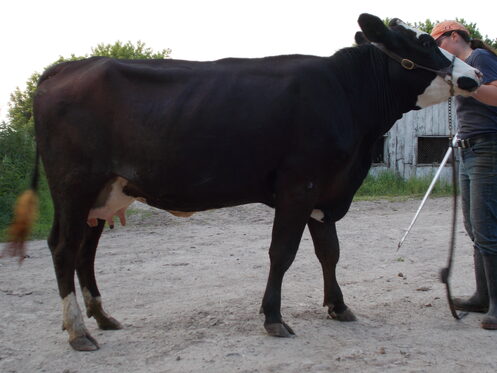 When we went to the Outdoor Farm Show for the first time in 2011, we were excited to see new stuff, like big tractors, innovative farm equipment, and robotic systems like the amazing Lely and DeLaval milking robots installed, and milking small herds of cows for the duration of the show.
When we went to the Outdoor Farm Show for the first time in 2011, we were excited to see new stuff, like big tractors, innovative farm equipment, and robotic systems like the amazing Lely and DeLaval milking robots installed, and milking small herds of cows for the duration of the show.
We saw all that and more, but what really caught my attention was the Fleckveihs. There were Holstein and Jersey cattle, among some others, on display in nice barns. The Fleckveihs were outside in a sheltered area, enclosed by a few strands of electric wire, and looking very comfortable being outside.
I don’t believe there were any purebred Fleckveihs in this group, most were percentage crosses to Holstein. One heifer was Fleckvieh x Holstein x Jersey. These cows and heifers were absolutely amazing. I have never before seen animals that were built so correctly, but without any fancy frills. Fleckveih crosses are not beautiful cows that will win ribbons at shows, so for herds who are hoping to earn money selling high class genetics, they are probably not a good idea. For the traditional family farm who is looking for ways to cut costs, this type of crossbred cow may be a smart option.
The crossbred, and fullblood Fleckveih is a dual purpose European breed that is very much function over fashion. You won’t see a Fleckveih with a huge, sharp, front end. What you will see, is a moderately sized, solid cow that is going to last through several lactations with little or no issues.
Don’t get me wrong, I love big, tall cows, but with the Holstein getting progressively bigger, how long is it going to take before we’re all breeding bovine giants that don’t fit on most of the housing available today?
Then there is the fertility and feet and leg issues that many Holstein breeders have to contend with on a daily basis. It’s not that their management is bad, because usually it’s very good, but it’s because the cows that we have been developing over the centuries have been bred primarily for one thing – to produce milk. Sometimes we as breeders lose sight of what’s really important. We know that putting the more milk in the tank gets us a bigger check. We often forget to count the costs of the extra feed it takes to feed a big cow, the cost of having a cow open (not pregnant) for longer than a certain period of time, and probably most importantly, the cost of raising a heifer from birth to calving, only to have her not last long term in the herd. A strong little cow like a Fleckveih, or Fleckveih cross could be the answer to these problems.
Many breeders are realizing the potential of crossing the Fleckveih to the Holstein. They give the Fleckveih a little boost in milk production, and pick up the fertility, great feet and legs, and usually a very low SCC. There aren’t many hard numbers available for Fleckveih production, and the costs of production in North America, because they haven’t become widely popular as milk cows, but in Europe, they are a popular commodity. Farmers report excellent milk production, and a great reduction in cost due to the Fleckveih’s ability to breed back quickly, and to give good milk with a low SCC. They also rarely report disease or lameness in the Fleckveih and have been able to reduce their use of antibiotics in their herd to next to nothing.
We currently have two Fleckveih x Holsteins milking in our herd. Claire, and Brooklyn.
Claire calved in March and milked in the top 25% of our Holstein, Milking Shorthorn and Jersey herd on her second DHI test.
If you were at the Lansdowne Fair in July, you would’ve seen Brooklyn in the Ag Education Barn. She has since calved as well, (She’s baby Barb’s mother).
Neither one of these cows would place at a dairy show, but I’ve come to the conclusion that winning a show means very little when it comes to whether a cow will be a healthy, productive, affordable cow to keep in the long term. Sacrificing some of the beauty of the Holstein and replacing it with a rounder, sturdier cow like the Fleckvieh could go a long way towards reducing some of the weaknesses that cost dairy farmers a lot of money.
As input costs continue to go up, farmers are constantly trying to find ways to cut their costs, without reducing any product quality or quantity. Breeding a cow that fits with the times could be the answer. Farms who have started crossing to Fleckveih have found that their cows continue to milk, even when their grain ration is reduced. This means they are able to produce more milk on forage (grass, hay, or silage). With less land available to grow feed, having cows that produce milk well on forages that we humans can’t eat, means we can head toward a more sustainable future.
I will always appreciate the look of a tall, angular Holstein, but I think there’s a lot of room in the dairy industry, for a round, sturdy, equally productive cow.